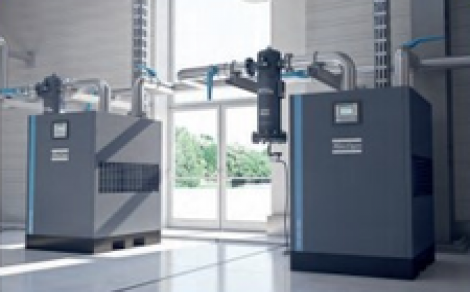Variable Speed Drive: why is it important for compressor users?

Typically, a fifth of UK industry’s electricity bill is attributed to the production of compressed air, but a substantial portion of the generated power dedicated to its production is actually energy wasted. That is why over 25 years ago, Atlas Copco addressed the problem by introducing VFD/VSD technology in its screw compressors. Now, in the form of the latest advanced solutions, compressors with VSD+ specifications are not only capable of achieving outstanding savings of up to 50% of their energy requirement, but they offer the attributes of total functional reliability and the essential benefit of smart communication. So how is a VSD compressor different from a conventional fixedspeed unit?
VSD v fixed-speed compressors
An air compressor with VSD automatically adjusts the compressor’s operating speed to match the production of compressed air to the demand in real-time. By varying the speed of its drive motor as air demand decreases, the VSD lowers the delivered airflow as well as the electrical power consumption. VSD compressors are specifically designed for applications where demand for compressed air fluctuates, such as facilities that operate different processes or multiple shifts, so flow demand increases and decreases throughout the day.
As the name suggests, a fixed-speed air compressor operates at the same speed whenever it is running and can only be stopped and started a certain number of times within a given time frame. By design, it always draws the amount of power needed to meet the maximum compressed air demand, even if the demand is less than maximum. Because the speed of the motor cannot change, whenever the demand for air fluctuates, instead of stopping the compressor it will be unloaded, throttled, and an air inlet valve will adjust to allow either more or less air to flow out.
In contrast, a VSD air compressor can operate anywhere in the range between its minimum and maximum speed. When demand increases, the motor speeds up. When demand decreases, the motor slows down. This capability saves energy because the compressor does not have to run flat out whenever it is operating.Where VSD makes sense: When demand fluctuates significantly between jobs, when demand varies by shift, on weekends or seasonally, or when manufacturing processes require tight tolerances for operating pressure. Where fixed speed makes sense: when the demand for compressed air fluctuates very little, it is worth noting that variable speed drive compressors are not necessarily appropriate for all industrial applications. If a variable speed drive compressor operates continuously at full speed, the switching losses of the frequency converter can result in lower energy efficiency than an otherwise identically sized fixed speed compressor.
How does VSD work?
Automatically adjusting the speed of the motor to match the air demand allows the pressure band of the system to be maintained within narrow tolerances. The motor speed of the compressor is regulated by frequency conversion, which results in the variation of airflow.
-
The Aftermarket Event
02 October, 2024, 9:30 - 03 October, 2024, 15:30
Farnborough International West Entrance, Gate F -
NFPC Annual Industry Exhibition
23 October, 2024, 9:30 - 16:00
Turner Road, Worksop, Nottinghamshire, S81 7AE -
AEMT Awards
21 November, 2024
Double Tree by Hilton Hotel, Coventry -
SMART Manufacturing & Engineering Week
04 - 05 June, 2025
NEC, Birmingham UK










